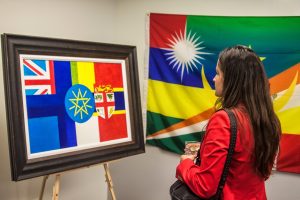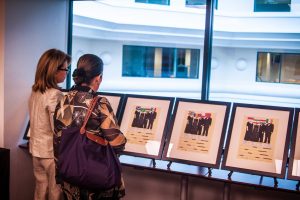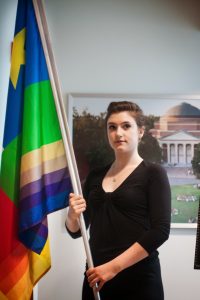
On Monday, October 27, Pedro Lasch, a Duke artist and faculty member, will present a special project at The Phillips Collection in Washington, DC.
***[Click here for registration information]***
A great profile in Duke Today of Lasch’s work highlights his incorporation of dozens of faculty, staff, and students around the university into his latest piece of art, and our colleagues at Duke in Washington were lucky enough to be among those involved.
Back in May, Duke in Washington hosted a preview reception featuring a live conversation between Lasch and Vesela Sretenovic, curator of modern and contemporary art at The Phillips Collection, to introduce select Washingtonians to Pedro’s work.
So what exactly is this project, and why is the nation’s capital the proper stage for such a work?
A Complex Idea
The description of Lasch’s Abstract Nationalism & National Abstraction: Anthems for Four Voices reads:
“Abstract Nationalism & National Abstraction: Anthems for Four Voices takes shape as a series of short public recitals, temporary exhibits, and social practice artworks in select foreign embassies, culminating with the largest manifestation of the project at the Phillips Collection during the International Forum (October 25-27, 2014). These multimedia performance events will incorporate audio and visual elements to explore questions of (multi)nationalism, cultural pluralism, independence, statehood, diplomatic and other themes so deeply related to the history and identity of nations and cultures.”
Still not sure what this is all about?
As you can tell from the description, Anthems is a complex project with many moving pieces, so let’s describe some of its basic concepts with a bulleted list:
- First, Lasch alphabetized every nation, as found in the 2001 World Almanac and Book of Facts.
- Then, Lasch selected groupings of four nations, as determined by their positions in the alphabet. For example, the United Kingdom, the United States, Uruguay, and Uzbekistan make up one grouping.
- The musical component of the project combines the national anthems of the four countries found in each group, arranged for four voices (Soprano, Alto, Tenor, Bass), into an overlapping and simultaneous performance.
- Furthermore, each anthem will be sung, not in its native tongue, but in the language of the country that follows it in the Almanac.
- At the same time, Lasch has created a visual element to the project by distilling the flags of each of these countries into their most basic design elements (stars, stripes, emblems, mottos, etc) and then creating paintings, videos, and even physical flags depicting the combination of these elements, thus creating a new flag representing each grouping.


Pretty simple right?
As Lasch and Sretenovic repeatedly emphasized at the Duke in Washington preview last spring, the project is constantly evolving and will continue to do so even after the performances and viewings themselves. There will be times where the project will feel like a traditional concert, with professional singers performing the arrangement of the anthems in The Phillips Collection’s concert hall. But other pieces of the project will be more unexpected.
“Imagine you are visiting the Phillips, totally unaware of this project,” said Lasch during the program.

“And you are sitting quietly in the Rothko room, enjoying the artwork, when in marches this singer, dressed in formal wear, carrying one of the flags, and singing the ‘Star-Spangled Banner’ in Spanish. You are going to say, ‘What is going on?,’ especially as you begin to notice that other singers are also singing other anthems in different galleries.'”
International Flavor
In addition to planning for the project at The Phillips Collection, Lasch and Sretenovic reached out to embassies in Washington, DC to make them aware of opportunities to share Anthems with foreign nationals and others who may closely identify with specific anthems included in a grouping.
Representatives from some of these embassies attended the preview reception at DIW, adding a diplomatic flavor to the evening.
“As we focused on producing a project specific to The Phillips Collection and Washington DC, we quickly realized that reaching out the embassies would be an important component. If you have walked even just a few blocks on Embassy Row, you know that the atmosphere and architecture created by this incredibly high concentration of foreign embassies is totally unique and unmatched by any city in the U.S., perhaps the world,” said Lasch.
Lasch added, “The work is as much about that as it is about modern art.”
The University As a One-Stop Art Shop
The live conversation portion of the evening also addressed the role of the university as cultural producer. Lasch highlighted the access to disciplines outside the arts as just one benefit of being an artist associated with a university.
“Universities have had a very important history in relation to the production of contemporary art, but this is often overlooked and underestimated by universities and artists themselves…[H]owever, universities have a great advantage over traditional museums, stand alone cultural institutions, or…commercial galleries,” explained Lasch.
“Where else, other than a university, will you find dozens of translators, a great choir and conductor, a composer, designers, performers, political scientists, humanists, historians and musicology researchers, all necessary collaborators for this very project?”
For Lasch and Sretenovic, the event was an opportunity to offer a small glimpse of Anthems to people and organizations whose interest and involvement can enhance the project’s reach. For Duke in Washington, it was a chance to highlight the cultural contributions of a major research university to those who may be more familiar with Duke’s contributions to undergraduate education or the hard sciences.
For more photos, please visit our Facebook gallery.
Learn more about Lasch’s performances at The Phillips Collection here.
